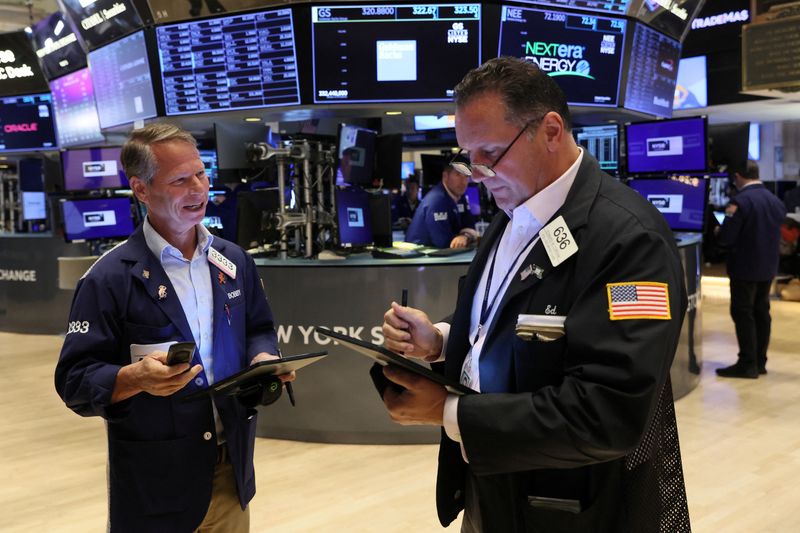
Futures higher, PPI ahead, LA wildfires in focus – what’s moving markets

Investing.com – US stock futures pointed into the green as investors geared up for more economic data and the release of corporate earnings from major Wall Street lenders this week. Traders are awaiting a reading of producer prices on Tuesday, with the outlook for inflation in focus. Meanwhile, Los Angeles firefighters are bracing for the return of high winds that could heap further fuel on to two wildfires devastating areas of the city.
1. Futures higher
US stock futures edged higher on Tuesday after a mixed session on Wall Street marked by elevated Treasury yields that have weighed on equities.
By 03:34 ET (08:34 GMT), the Dow futures contract had increased by 153 points or 0.4%, S&P 500 futures had risen by 31 points or 0.5%, and Nasdaq 100 futures had advanced by 151 points or 0.7%.
The Dow Jones Industrial Average and the S&P 500 both eked out gains on Monday, while the tech-heavy Nasdaq Composite dipped. The benchmark 10-year US Treasury note yield hit its highest level in 14 months, reflecting worries that recent economic data and President-elect Donald Trump’s strict tariff plans could reignite lingering price pressures.
Doubts have subsequently grown around whether the Federal Reserve will potentially roll out interest rate cuts this year, with analysts at Bank of America even suggesting the central bank could once again hike borrowing costs.
In individual stocks, shares in healthcare firms like UnitedHealth Group (NYSE:UNH) and Humana (NYSE:HUM) jumped after the Biden administration proposed 2026 reimbursement rates for Medicare Advantage plans that would lead to a 2.2% uptick in payments.
But semiconductor stocks dipped on news the US government had said it would further restrict exports of cutting-edge artificial intelligence chips.
2. PPI ahead
Markets will have the chance to parse through a monthly gauge of producer prices on Tuesday.
Economists expect the producer price index for final demand to rise by 0.4% in December, matching the prior month’s pace. In the 12 months through December, PPI is seen increasing by 3.4% — an acceleration from 3.0%.
A spike in egg prices, fueled by avian flu outbreak, helped push the rate of growth in producer prices to its highest in five months in November, although cooling services costs bolstered hopes around the staying power of a recent disinflationary trend.
The report from the Labor Department is due to be followed up later in the week with a fresh look at consumer prices. The data points, along with last week’s blockbuster employment numbers, could influence forecasts for the trajectory of inflation — and, by extension, Fed monetary policy — in the months ahead.
3. LA braces for return of high winds
Firefighters in Los Angeles were bracing for the return of strong winds that could further exacerbate two large wildfires that have already decimated neighborhoods across the city.
A red flag warning was in effect late on Monday ahead of an anticipated pick-up in warm, dry Santa Ana winds. Forecasters are predicting that gusts may reach up to 75 mph, Reuters reported.
The fires, which have swept through an area the size of Washington, D.C., have killed at least 24 people and damaged 12,000 structures, according to Reuters.
Analysts are moving to assess the financial impact of the fires, with the insurance industry expected to be hit in particular. Insured losses could climb to $30 billion, Wells Fargo (NYSE:WFC) analysts have estimated.
Elsewhere, Edison International’s (NYSE:EIX) California unit was slapped with a slew of lawsuits blaming the firm’s equipment for igniting one of the state’s worst wildfires, which devastated the Los Angeles county over the past week. A group of homeowners, business owners and others facing property damage filed several suits against Edison in the Los Angeles Superior Court on Monday, alleging that Southern California Edison power lines had triggered the fire due to a lack of maintenance.
4. BP sees up to $2 billion in charges
BP (LON:BP) has said it expects to incur impairment charges worth between $1 billion to $2 billion, while upstream production at the oil-and-gas major is projected to decrease.
In a trading update for the final three months of last year, the British company said the non-cash, post-tax charges would be attributable across all segments of the business.
Meanwhile, upstream production in the fourth quarter is tipped be lower compared to the prior quarter, with output dropping in both oil production and gas and low carbon energy.
Other business and corporate underlying annual charges are also now seen at $600 million for 2024, up from a prior range of $300 million to $400 million, due to foreign exchange losses, BP (NYSE:BP) said.
The firm is due to publish its fourth quarter and full-year earnings on February 11. London-listed shares in BP fell in early trading on Tuesday.
5. Crude retreats
Oil prices slipped lower, retreating from the four-month highs that were triggered by new US sanctions on Russian oil exports and worries over supply disruptions.
By 03:34 ET, the US crude futures (WTI) dropped 0.3% to $77.10 a barrel, while the Brent contract fell 0.4% to $80.69 a barrel.
Oil has gained strongly over the prior two sessions after the Biden administration introduced its most comprehensive sanctions package to date, aimed at cutting into Russia’s oil and gas revenues.
These developments are expected to significantly disrupt Russian oil exports, compelling major importers like China and India to seek alternative suppliers in regions such as the Middle East, Africa, and the Americas.
(Reuters contributed reporting.)


